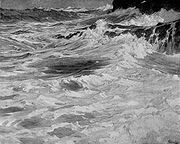
Frederick Judd Waugh
Encyclopedia


Marine art
Marine art or maritime art is any form of figurative art that portrays or draws its main inspiration from the sea. Maritime painting is a genre that depicts ships and the sea—a genre particularly strong from the 17th to 19th centuries...
ist. During World War I
World War I
World War I , which was predominantly called the World War or the Great War from its occurrence until 1939, and the First World War or World War I thereafter, was a major war centred in Europe that began on 28 July 1914 and lasted until 11 November 1918...
, he designed ship camouflage
Camouflage
Camouflage is a method of concealment that allows an otherwise visible animal, military vehicle, or other object to remain unnoticed, by blending with its environment. Examples include a leopard's spotted coat, the battledress of a modern soldier and a leaf-mimic butterfly...
for the U.S. Navy, under the direction of Everett L. Warner.
Background
Born in Bordentown, New JerseyBordentown, New Jersey
Bordentown City is in Burlington County, New Jersey, United States. As of the 2010 United States Census, the city population was 3,924. Bordentown is located at the confluence of the Delaware River, Blacks Creek and Crosswicks Creek...
, Waugh was the son of a well-known Philadelphia portrait painter, Samuel Waugh
Samuel Waugh
Samuel Waugh was a 19th century painter.Born in Mercer, Pennsylvania, he became one of the most famous portrait painters of Philadelphia...
. He studied at the Pennsylvania Academy of Fine Arts with Thomas Eakins
Thomas Eakins
Thomas Cowperthwait Eakins was an American realist painter, photographer, sculptor, and fine arts educator...
, and at the Académie Julian
Académie Julian
The Académie Julian was an art school in Paris, France.Rodolphe Julian established the Académie Julian in 1868 at the Passage des Panoramas, as a private studio school for art students. The Académie Julian not only prepared students to the exams at the prestigious École des Beaux-Arts, but offered...
in Paris
Paris
Paris is the capital and largest city in France, situated on the river Seine, in northern France, at the heart of the Île-de-France region...
, with Adolphe-William Bouguereau. After leaving Paris, he moved to England, residing on the island of Sark
Sark
Sark is a small island in the Channel Islands in southwestern English Channel, off the French coast of Normandy. It is a royal fief, geographically located in the Channel Islands in the Bailiwick of Guernsey, with its own set of laws based on Norman law and its own parliament. It has a population...
in the English Channel
English Channel
The English Channel , often referred to simply as the Channel, is an arm of the Atlantic Ocean that separates southern England from northern France, and joins the North Sea to the Atlantic. It is about long and varies in width from at its widest to in the Strait of Dover...
, where he made his living as a seascape
Seascape
A seascape is a photograph, painting, or other work of art which depicts the sea, in other words an example of marine art. By a backwards development, the word has also come to mean the view of the sea itself, and be applied in planning contexts to geographical locations possessing a good view of...
painter (Havens 1969).
In 1908, Waugh returned to the U.S. and settled in Montclair Heights, New Jersey. He had no studio until art collector William T. Evans (a railroad financier and President of Mills Gibbs Corporation, a dry goods firm) offered him one in exchange for one painting a year. In later years, he lived on Bailey Island, Maine, and in Provincetown, Massachusetts
Provincetown, Massachusetts
Provincetown is a New England town located at the extreme tip of Cape Cod in Barnstable County, Massachusetts, United States. The population was 3,431 at the 2000 census, with an estimated 2007 population of 3,174...
. In 1914, he was a judge of the art exhibit on Monhegan Island, ME during he 1914 Ter-Cenetary celebration of the Vogage of Captain John Smith.
Camouflage Service
In 1918, Waugh was recommended to serve as a camouflage artist (or camoufleur) for the U.S. Navy, as a member of the Design Section of its marine camouflage unit (Behrens 2002, 2009). That section was located in Washington, D.C.Washington, D.C.
Washington, D.C., formally the District of Columbia and commonly referred to as Washington, "the District", or simply D.C., is the capital of the United States. On July 16, 1790, the United States Congress approved the creation of a permanent national capital as permitted by the U.S. Constitution....
, and was headed by American painter Everett L. Warner (Warner 1919).
According to a biography of Waugh (Havens 1969), “Many large ships, including the Leviathan, were painted according to his designs. Though the enterprise was of course a team effort in which no man played a solo part, he had every reason to be proud of his record. Only one ship with his system of camouflage was lost during the war” (p. 154).
See also
- Dazzle camouflageDazzle camouflageDazzle camouflage, also known as Razzle Dazzle or Dazzle painting, was a camouflage paint scheme used on ships, extensively during World War I and to a lesser extent in World War II...
- Everett L. Warner
- Harold Van BuskirkHarold Van BuskirkHarold Van Buskirk was an American architect and fencing champion, and a three-time member of the US Olympic fencing team...
- The Rise of the Muneswww.theriseofthemunes.com
External links
- http://www.theriseofthemunes.comOriginal illustrations by Frederick Waugh
- Dazzle camouflage designs by Waugh and other artists

